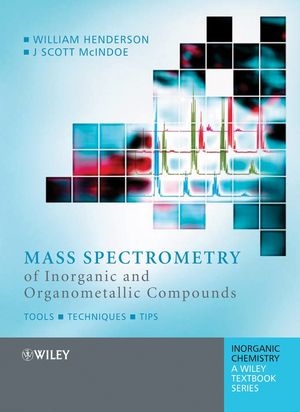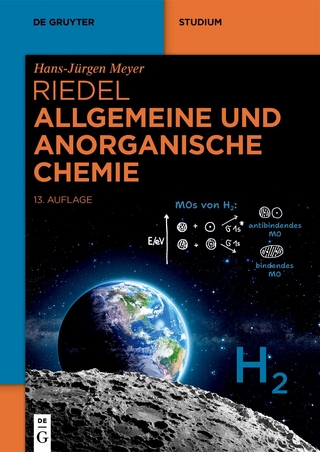
Mass Spectrometry of Inorganic and Organometallic Compounds
Wiley-Interscience (Verlag)
978-0-470-85016-9 (ISBN)
- Titel z.Zt. nicht lieferbar
- Versandkostenfrei innerhalb Deutschlands
- Auch auf Rechnung
- Verfügbarkeit in der Filiale vor Ort prüfen
- Artikel merken
William Henderson is the author of Mass Spectrometry of Inorganic and Organometallic Compounds: Tools - Techniques - Tips, published by Wiley. J. Scott McIndoe is the author of Mass Spectrometry of Inorganic and Organometallic Compounds: Tools - Techniques - Tips, published by Wiley.
Preface xv
List of commonly-used abbreviations xix
1 Fundamentals 1
1.1 Introduction 1
1.2 Inlets 1
1.3 Collision-Induced Dissociation 2
1.3.1 Bond dissociation energies from CID studies 4
1.3.2 Presentation of CID data 4
1.4 Detectors 6
1.5 Mass Resolution 7
1.5.1 Mass accuracy 10
1.6 Data Processing 12
1.7 Isotopes 14
1.7.1 Isotopic abundances of the elements 17
1.7.2 Isotope pattern matching 19
References 21
2 Mass analysers 23
2.1 Introduction 23
2.2 Sectors 23
2.2.1 Ms/ms 26
2.2.2 Summary 26
2.3 Quadrupoles 27
2.3.1 Ms/ms 29
2.3.2 Summary 30
2.4 Quadrupole Ion Trap 30
2.4.1 MS/MS and MS n 33
2.4.2 Summary 34
2.5 Time-of-Flight 35
2.5.1 Reflectron instruments 37
2.5.2 Orthogonal TOF (oa-TOF) 38
2.5.3 Ms/ms 38
2.5.4 Summary 40
2.6 Fourier Transform Ion Cyclotron Resonance 40
2.6.1 Ms/ms 43
2.6.2 Summary 44
References 45
3 Ionisation techniques 47
3.1 Introduction 47
3.2 Electron Ionisation 47
3.2.1 Fragmentation of metal-containing compounds 50
3.2.2 Applications 51
3.2.3 Summary 53
3.3 Chemical Ionisation 54
3.3.1 Applications 56
3.3.2 Summary 57
3.4 Field Ionisation/Field Desorption 58
3.4.1 Summary 59
3.5 Plasma Desorption 60
3.5.1 Applications 60
3.5.2 Summary 62
3.6 Fast Atom Bombardment / Liquid Secondary Ion Mass Spectrometry 62
3.6.1 Matrices 63
3.6.2 Ions observed in FAB/LSIMS 65
3.6.3 Applications 66
3.6.4 Summary 71
3.7 Matrix Assisted Laser Desorption Ionisation 72
3.7.1 Matrices 75
3.7.2 MALDI of air-sensitive samples 76
3.7.3 Applications 77
3.7.4 Summary 87
3.8 Inductively Coupled Plasma Mass Spectrometry 88
3.8.1 Applications 89
3.8.2 Summary 90
3.9 Electrospray Ionisation 90
3.9.1 Electrochemistry in the ESI process 92
3.9.2 Multiply-charged species 94
3.9.3 Nanospray 95
3.9.4 ESI MS: Practical considerations 96
3.9.5 Applications 99
3.9.6 Summary 99
References 100
4 The ESI MS behaviour of simple inorganic compounds 107
4.1 Introduction 107
4.2 Simple Metal Salts 107
4.2.1 Salts of Singly-charged Ions, M+ X- 107
4.2.2 Salts of multiply-charged ions, e.g M2+ (X-)2 ,M3+ (X)3 etc 112
4.2.3 Negative-ion ESI mass spectra of metal salts 116
4.2.4 ESI MS behaviour of easily-reduced metal ions: copper(II), iron(III) and mercury(II) 117
4.3 Polyanions Formed by Main Group Elements 119
4.4 Oxoanions Formed by Main Group Elements 119
4.5 Borane Anions 122
4.6 Fullerenes 122
4.7 Inorganic Phosphorus Compounds: Phosphoranes and Cyclophosphazenes 123
4.8 Summary 123
References 123
5 The ESI MS behaviour of coordination complexes 127
5.1 Introduction 127
5.2 Charged, ‘Simple’ Coordination Complexes 128
5.2.1 Cationic coordination complexes 128
5.2.2 Anionic metal halide complexes 132
5.2.3 Highly-charged, anionic transition metal complexes – cyanometallate anions. 134
5.3 (Neutral) Metal Halide Coordination Complexes 136
5.4 Metal Complexes of Polydentate Oxygen Donor Ligands: Polyethers, Crown Ethers, Cryptands and Calixarenes 139
5.5 Porphyrins and Metalloporphyrins 141
5.6 Metal Alkoxides – Highly Moisture-Sensitive Coordination Compounds 144
5.7 β-Diketonate Complexes 145
5.8 Metal Complexes of Carbohydrates 148
5.9 Metal Complexes of Amino Acids, Peptides and Proteins 149
5.9.1 Amino acids 149
5.9.2 Proteins and peptides 150
5.10 Oxoanions, Polyoxoanions and Related Species 151
5.10.1 Simple transition metal oxoanions 151
5.10.2 Reactivity studies involving molybdate and tungstate ions 154
5.10.3 Polyoxoanions 155
5.10.4 Miscellaneous oxo complexes 157
5.11 Metal Clusters 157
5.12 Compounds with Anionic Sulfur and Selenium Donor Ligands 158
5.12.1 Metal sulfide, selenide and related complexes 158
5.12.2 Metal dithiocarbamate and dithiophosphate complexes 159
5.12.3 Metal thiolate complexes 160
5.13 Characterisation of Metal-Based Anticancer Drugs, their Reaction Products and Metabolites 163
5.13.1 Characterisation of anticancer-active platinum complexes 163
5.13.2 Reactions of platinum anticancer drugs with biomolecules and detection of metabolites 165
5.13.3 Other non-platinum anticancer agents 166
5.14 In situ Formation of Coordination Complexes as an Ionisation Technique 166
5.15 Summary 167
References 168
6 The ESI MS behaviour of main group organometallic compounds 175
6.1 Introduction 175
6.2 Organometallic Derivatives of Group 14 Elements 175
6.2.1 Organosilicon compounds 175
6.2.2 Organogermanium compounds 176
6.2.3 Organotin compounds 176
6.2.4 Organolead compounds 178
6.3 Organometallic Derivatives of Group 15 Elements 180
6.3.1 Organophosphorus compounds 180
6.3.2 Organoarsenic compounds 185
6.3.3 Organoantimony and -bismuth compounds 187
6.4 Organometallic Derivatives of Group 16 Elements; Organosulfur, -Selenium and -Tellurium Compounds 188
6.5 Organomercury Compounds 188
6.6 Other Organometallic Derivatives 190
6.7 Summary 190
References 190
7 The ESI MS behaviour of transition metal and lanthanide organometallic compounds 195
7.1 Introduction 195
7.2 Metal Carbonyl Complexes 195
7.2.1 Ionic mononuclear metal carbonyl compounds 196
7.2.2 Ionic metal carbonyl clusters 196
7.2.3 Neutral metal carbonyl compounds 198
7.2.4 Oxidation and reduction processes involving metal carbonyls 201
7.2.5 Characterisation of reaction mixtures involving metal carbonyl clusters 201
7.2.6 Fragmentation of transition metal carbonyl clusters; electrospray as a source of bare metal clusters 203
7.2.7 The use of ‘Electrospray-friendly’ ligands in organometallic chemistry 204
7.3 Metal Isocyanide Complexes 204
7.4 Metal Cyclopentadienyl and Related Complexes 205
7.4.1 Ferrocene-based compounds 205
7.4.2 Use of ferrocene derivatives as electroactive derivatisation agents for electrospray ionisation 209
7.4.3 Other metallocene systems 210
7.4.4 Monocyclopentadienyl complexes 210
7.5 η3 Metal 3 -allyl Complexes 211
7.6 Metal Arene Complexes 212
7.7 Formation of π-Hydrocarbon Complexes and their Use as an Ionisation Aid 212
7.8 Metal-Acetylene/acetylide Complexes and Complexes of Metal-Acetylides 213
7.9 Transition Metal -Alkyl and Aryl Complexes 214
7.10 Mass Spectrometry of Lanthanide Organometallic Complexes 215
7.11 Summary 215
References 215
8 A selection of special topics 221
8.1 Introduction 221
8.2 Characterisation of Dendrimers Using ESI and MALDI-TOF MS Techniques 221
8.3 Investigating the Formation of Supramolecular Coordination Assemblies Using ESI MS 222
8.4 Using ESI MS as a Tool for Directing Chemical Synthesis: A Case Study Involving the Platinum Metalloligands [Pt 2 (µ–E) 2 (PPh 3) 4] 224
8.4.1 Background 224
8.4.2 Analysis of the metalloligands; formation of protonated species 225
8.4.3 Reactivity of [Pt 2 (µ–E) 2 (PPh 3) 4] towards metal-halide complexes 226
8.5 Applications of ESI MS in the Detection of Reactive Intermediates and Catalyst Screening 228
8.5.1 Detection of intermediates in reactions of organic compounds 228
8.5.2 Detection and chemistry of reaction intermediates in the gas phase 230
8.5.3 Screening of new catalysts using mass spectrometry 231
References 232
Appendix 1 Naturally occurring isotopes 235
Appendix 2 Periodic table of the elements 247
Appendix 3 Alphabetical list of elements 249
Appendix 4 Glossary of terms 251
Appendix 5 Useful sources of information 265
Index 267
| Erscheint lt. Verlag | 11.2.2005 |
|---|---|
| Reihe/Serie | Inorganic Chemistry: A Textbook Series |
| Sprache | englisch |
| Maße | 191 x 250 mm |
| Gewicht | 567 g |
| Themenwelt | Naturwissenschaften ► Chemie ► Anorganische Chemie |
| ISBN-10 | 0-470-85016-7 / 0470850167 |
| ISBN-13 | 978-0-470-85016-9 / 9780470850169 |
| Zustand | Neuware |
| Haben Sie eine Frage zum Produkt? |
aus dem Bereich


